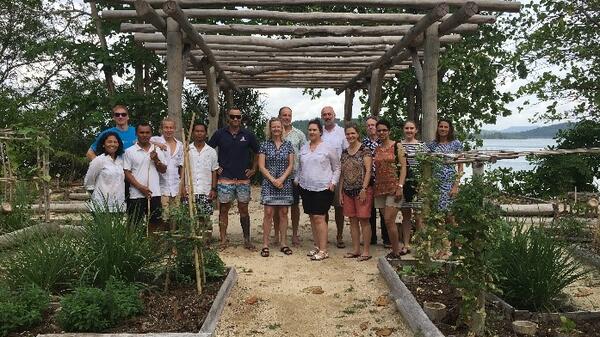Workshop on Tourism Revenues Funding Conservation Efforts
ASU Faculty: Christine Vogt, Director, Center for Sustainable Tourism AND Megha Budruk, Association Professor, both in School of Community Resources and Development
Location: Cempedak Island, Indonesia Sustainable Hotel Facility
https://www.cempedak.com/
Conservation International (CI) organized a two-day workshop to share best practices, and develop tools and guidelines for increasing tourism revenues that may be used to fund marine conservation in the CI program areas of Timor-Leste and Samoa. As part of the technical support, Vogt and Budruk were asked to prepare and deliver a half-day workshop that provided CI staff with a state of knowledge on tourism and tourism-related revenue programs. The idea was to explore how such revenue programs could contribute to new funding that Conservation International (CI) could implement in Timor Leste and Samoa. In addition to ASU’s presentation, Mark Erdmann, Vice President, Marine, Asia-Pacific for CI delivered a case study on Raja Ampat and Bunaken, Indonesia to showcase the development and implementation of a successful revenue program through marine protection area user fees (mostly scuba divers). A needs assessment was also provided by CI staff working in Timor Leste and Samoa to set the stage for an opportunity matrix exercise that occurred on the second day.
ASU faculty participated in the second-day work sessions where participants outlined concrete funding ideas and priorities for Timor-Leste and Samoa. CI staff and ASU faculty supported the CI Country Directors in the writing of plans and stakeholder support sessions. These sessions will likely occur in the next few months. CI is hoping to use these two countries as case studies for several other countries in the Asia-Pacific region who are interested in the potential of tourism as a funding source for conservation programs.
A discussion of research that might support these efforts also occurred. Given the focus on tourism, Vogt and Budruk recommended that secondary data collected by airport immigration processing or service providers can allow for simple monitoring of in-country tourism activities. These figures can also help to estimate potential revenues from a fee or tax program. Primary or new research studies were also discussed including a willingness to pay and impact studies on Marine Protected Areas (MPAs). Such studies can provide a baseline before any new management program funded by a new fee or tax is designed and implemented.
A few areas where ASU could play a role:
- Analysis of Timor Leste and Samoa’s legal system to determine which statute allows for a mandatory fee or tax collection from tourists.
- Design of a visitor study to understand the tourist profile, visit motivations and expectations, willingness to pay visitor fees, and potential educational programs.
- Training of potential tourism personnel from Timor Leste and Samoa. Vogt and Budruk mentioned the HAITC program in China as a possible institution where such training could occur.
- Given the increasing importance of tourism as a source of conservation funding, Vogt and Budruk suggested that CI explore nominating an ASU-CI professor of practice with a focus on tourism. Due to her doctoral training in Parks, Recreation and Tourism, Tracy Farrell, VP Strategies and Fundraising, APFD, at Conservation International would be an ideal candidate.
